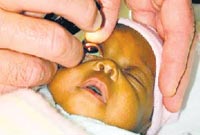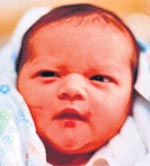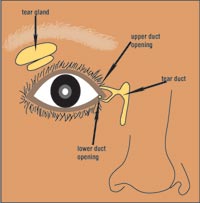
Look into their eyesChildren can be prone to a variety of eye disorders. Early diagnosis and treatment of these can prevent many serious conditions, says Dr. H. Palihakkara, Consultant Ophthalmologist, describing the most common eye disorders seen in children and how to identify them. Eye disorders in neonates (Newborns) Retinopathy of Prematurity (ROP) This is a disorder of the blood vessels of the retina (the light sensitive part of the eye) that is commonly seen in premature babies as well as those with low birth weights. These blood vessels may not be fully developed in some areas in these babies and when they are exposed to the normal environment, some abnormalities in the retina are caused, which may lead to retinal detachment.
Generally, the more premature the baby and the lower the birth weight, the greater the risk for developing ROP. Early detection is important for treatment since if neglected, it can cause blindness. Even if the condition is not present at birth, such babies must be taken for regular eye examinations until the risk has been eliminated. Blocked tear ducts Sometimes, at birth, the tear duct that connects the eye to the nose is blocked. In this case, excess tears, which usually emerge through the nose, come out through the eyes causing the eyes to tear excessively. There may be infection due to the collection of tears. This condition usually settles by itself within one-two years. Parents are asked to gently massage the inner corners of the eyes where the tear ducts are, to open them up. In rare cases, probing may be necessary, where a tube is inserted through the opening to remove the blocks. Redness Redness of the eye may indicate damage to the cornea. If instrumentation such as forceps or a vacuum was used during delivery, such damage may have occurred, and therefore any reddish patches in the eye of the newborn must be reported to the doctor immediately. Discharge It is common for most newborns to have a mild discharge from their eyes. While this may be normal, it may also be the result of a serious infection from the birth canal, such as gonorrhea. This can cause damage to the cornea and requires immediate treatment. White pupils If the pupils of a baby's eyes appear to be white, it may be due to a congenital cataract, tumour (retinoblastoma) or some other abnormality of the retina. Congenital cataracts are mainly caused by viral infections such as Rubella during the first three months of pregnancy. These can be treated by surgery. Squints
It is common for babies to appear cross-eyed during the first three months after birth. During this time however they usually begin to focus and follow moving objects with their eyes. If the child still appears to have a squint after this period, it may be indicative of a vision disorder. The squint can be cured by treating the disorder. Muscle paralysis in one or two of the six muscles that keep the eyes in position may also result in a squint - this however, is rare in children. Other childhood eye disorders Refractive errors Sometimes the shape of the cornea and the eye are not perfect and the image on the retina is blurred or distorted. These imperfections in the focusing power of the eye are called refractive errors. Myopia or short-sightedness - This is the most common refractive error seen in children and may occur in infants, toddlers and older children as well. Frequent blinking, squinting, moving very close to the television when watching and holding books too close to the eyes to read, are some of the signs parents should look for. Hypermetropia or far - sightedness is relatively rare in children. Amblyopia - This is also known as 'lazy eye'. Amblyopia may be inherited or caused by uncorrected refractive errors. It results when there is a difference in the quality of the images sent to the brain by each eye. For a child with normal vision, the images from both eyes are fused into one by the visual cortex, or that part of the brain which receives visual data. If one eye is weaker, then the brain tends to choose the better image and disregards the image sent by the weaker eye. In this case the visual cortex does not develop properly for that eye.
Most babies with Amblyopia do not show obvious signs of the condition. Squinting and constant rubbing of one eye may be indications. If Amblyopia is diagnosed before the age of five it can be cured completely by means of glasses or other methods. However, a delay in treatment may mean that the child will never have 100% vision. For this reason it is important that all children have regular eye examinations after the age of two and a half, or three. There are simple eye-tests that the ophthalmologist uses on pre-school age children. Allergies Vernal kerato conjunctivitis - Children who are given to allergic reactions such as asthma or catarrh may also develop symptoms in their eyes such as swelling, tearing, redness, itchiness and blurring of vision. This is usually caused by exposure to dust or pollen in the environment and sometimes pets. While this condition can be completely cured by long-term treatment, neglect may lead to permanent damage. It is important to continue treatment even after the symptoms have disappeared. Infections Styes - These are caused by bacterial infections and can be avoided by teaching children to keep their eyelids clean. Styes require long term treatment such as eye drops and ointments. Conjunctivitis or Sore Eyes - This is an inflammation of the conjunctiva (the outermost layer of the eye and the inner surface of the eyelids) caused by a bacterial infection. Redness, irritation and discharge are the common signs. Conjunctivitis is transmitted from hand to eye. Infection can be avoided by not touching the eyes and regularly washing the hands. Those who have the infection must make sure to wipe the discharge from their eyes with clean tissues that they dispose of immediately. Trauma Young children are often prone to injury at home or at school that may include trauma to the eyes. Injury from sharp objects such as pens or pencils or lacerations from the sharp edges of objects like plastic sheets are frequently seen. In such cases parents are advised to gently wipe off any foreign matter in the eye and cover it with clean cotton wool or gauze. They should not apply anything on the eye, but immediately take the child to the nearest hospital. Blunt trauma - from someone's fist, a ball, shuttlecock or something similar - can also be dangerous despite the absence of outward symptoms. Retinal tears and occult bleeding or bleeding inside the eye, may occur and possibly lead to cataracts or glaucoma. Therefore any collision involving the eyes should be reported immediately even if there is no pain or other indications of trauma. Chemicals such as lime, acetic acid and citric acid can cause permanent damage if splashed into the eye and should be kept away from children at all times. |
|| Front
Page | News | Editorial | Columns | Sports | Plus | Financial
Times | International | Mirror | TV
Times | Funday
Times | Medi Scene || |
| |
Copyright
2007 Wijeya
Newspapers Ltd.Colombo. Sri Lanka. |


